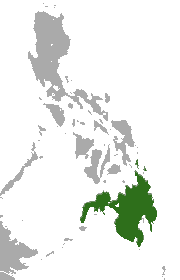Mindanao treeshrew
| Mindanao treeshrew[1] | |
|---|---|
| Scientific classification | |
| Kingdom: | Animalia |
| Phylum: | Chordata |
| Class: | Mammalia |
| Order: | Scandentia |
| Family: | Tupaiidae |
| Genus: | Urogale Mearns, 1905 |
| Species: | U. everetti |
| Binomial name | |
| Urogale everetti (Thomas, 1892) | |
 | |
| Mindanao treeshrew range | |
The Mindanao treeshrew (Urogale everetti), also called the Philippine tree shrew, is a species of treeshrew endemic to the Mindanao region in the Philippines.[2] It is the only member of the genus Urogale. The scientific name commemorates British colonial administrator and zoological collector Alfred Hart Everett.
Range and habitat
It is found, as its name suggests, in Mindanao, in the Philippines. It lives in rain forests and montane forests.
Description
It is the heaviest treeshrew, weighing about 355 g, and is terrestrial.[3] The body is 17–20 cm, and the tail is 11–17 cm. It has a particularly elongated snout and a rounded, even-haired tail. The fur is brownish, but with orange or yellow underparts.
It is diurnal in its habits, and it climbs well and runs fast on the ground.
Diet
Its diet is varied. It includes insects, lizards, young birds, bird's eggs, and fruit.
Reproduction
In the wild, it is thought to nest on the ground or on cliffs. Their breeding habits have been observed in captivity, where females have produced one or two young after a gestation period of 54–56 days.
References
- ↑ Helgen, K.M. (2005). Wilson, D.E.; Reeder, D.M., eds. Mammal Species of the World: A Taxonomic and Geographic Reference (3rd ed.). Johns Hopkins University Press. pp. 108–109. ISBN 978-0-8018-8221-0. OCLC 62265494.
- 1 2 Tabaranza, B.; Gonzalez, J. C.; Ambal, G. & Heaney, L. (2008). "Urogale everetti". IUCN Red List of Threatened Species. Version 2008. International Union for Conservation of Nature. Retrieved 30 December 2008.
- ↑ Napier JR, Napier PH. (1968) A handbook of living primates. Morphology, ecology and behaviour of nonhuman primates. Academic, London
- Macmillan Illustrated Animal Encyclopedia
